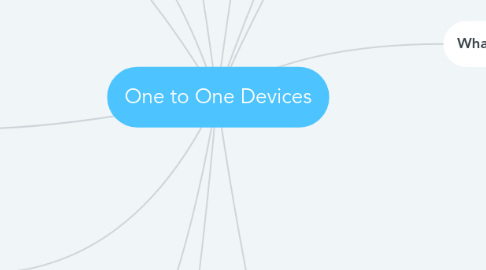
1. Direct contact with teachers & class
2. Equity
2.1. All have a device
2.2. All have *same* device
2.3. Research shows (Harper & Milman 2016)
2.3.1. Lower socio-economic students performed better than previously
2.3.2. "1:1 programs have the potential to reduce socio-economic and ability-based achievement gaps"
2.3.3. closing poverty-related attainment gap
3. Inclusion
3.1. benefit from international community of like-minded users
3.2. Adapts to learners' needs
3.2.1. Font size
3.2.2. Colour
3.2.3. Reading out loud
3.2.4. Dictation
3.2.5. Website reduction for cleaner reading
3.2.6. Photos & movies allow expression for those who find it hard
3.3. Engagement of learners not in school
3.3.1. VLE
4. Collaboration
4.1. enables online joint working in school and out of school
5. Teachers
5.1. Share resources
5.2. Create resources than can be adapted through the years
6. iPads
6.1. engagement in learning not possible prior to its invention
6.1.1. Virtual Reality
6.1.2. Augmented reality
6.1.3. Portable audio, photo, movie editing device
6.2. School environment
6.2.1. iPads change the spaces and mechanisms student use to learn.
6.2.2. No more computer labs
6.2.3. Learning & engagement can take place anywhere
7. Pedagogy
7.1. Increase in pupil-led learning
7.2. Increase in information literacy
7.3. Shift from logistical whole-class instruction to more individualised teaching
7.3.1. "teachers observed that technology enabled them to spend more time engaged in side-by-side coaching, one-to-one support, and providing immediate feedback to the students in the classroom, all of which are correlated with positive learning outcomes." (Liu et al., 2014)
8. Needs pedagogical change
8.1. Staff resistance to change
9. Over all school culture not supportive
10. Why do some schools fail?
10.1. Poor infrastructure
10.1.1. Requires integration in every curricular area
10.2. Poor teacher training
10.3. Desire needs to come from teachers
10.4. Staffing
10.4.1. it's not the device that makes the difference, but the staff
10.5. Traditional and fixed curricula impede integration of technology
10.5.1. CfE is not fixed so can be flexible to accommodate technology
10.6. Insufficient tech support
10.7. Insufficient WiFi infrastructure
11. What makes 1:1 work?
11.1. Requires curricular integration as well as technological integration
11.1.1. Curriculum needs to be designed with tech in mind
11.2. Need an understanding of the relationship between curriculum, pedagogy and technology
11.3. Curriculum can be a boundary or a gateway to tech integration
11.4. Time required for teachers to redesign curriculum leveraging iPads to support learning & teaching
11.5. Teachers' understanding of the device matters
11.6. Requires shifts in belief and behaviours at individual & organisational level
11.7. Creation of time for teachers to collaborate with each other
11.8. Correct culture in school
11.8.1. Safe to speak up
11.8.2. Take calculated risks
11.8.3. learn
11.9. Feedback from XMA
11.9.1. BPHS has perfect conditions to make 1:1 a success
12. Impact of 1:1
12.1. Not a magic wand
12.2. Accelerates learning
12.3. Completely dependant on teacher
12.4. From Harper & Milman 2016
12.4.1. Attainment
12.4.1.1. Research shows
12.4.1.1.1. attainment increases with device use
12.4.1.1.2. 1:1 device pupils do better than 1:5 device pupils
12.4.1.1.3. device more likely to be used at home
12.4.1.1.4. Socio-economic barriers broken down in part at least
12.4.1.1.5. Mostly to do with teachers' approaches
12.4.1.1.6. Multiple researchers have shown "1:1 devices in classrooms can impact student achievement regardless of of students' SES <socio-economic status> or ability level."
12.4.2. Classroom experiences
12.4.2.1. Encourages collaboration
12.4.2.2. Promotes more sophisticated enagement
12.4.2.2.1. extensive written expreseeion
12.4.2.2.2. creativity
12.4.2.2.3. multimedia presentations
12.4.2.2.4. data analysis
12.4.2.2.5. Promotes pupils' sence of empowerment & accomplishment
12.4.2.2.6. relied less on teacher pace
12.4.2.3. Greater relationships between pupils & teachers
12.4.2.3.1. greater ownership of learning
12.4.2.3.2. pupils communicated better with teachers
12.4.2.4. Promotes greater differentiation
12.4.2.4.1. differentiation in content
12.4.3. Learner engagement
12.4.3.1. More creative responses to texts
12.4.3.2. Increased in pupils from less affluent backgrounds
12.4.4. Recommendations
12.4.5. “Studies of student achievement indicated that schools facing achievement gaps related to ability or socio-economic status could benefit from 1:1 programs. Likewise, changes to the classroom environment cultivated by 1:1 technology implementation offered students more collaborative and individualized learning opportunities.”
